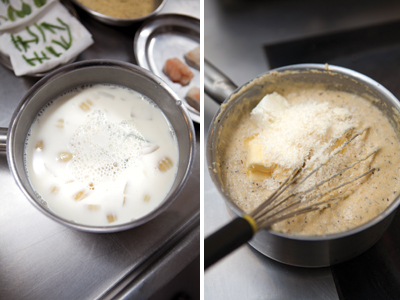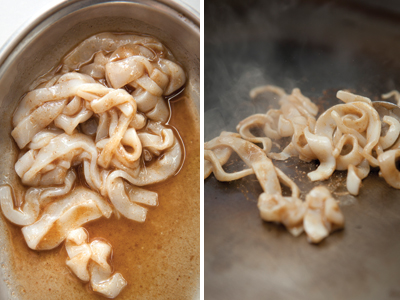Chef masterclass – Cuttlefish by Alyn Williams
Cuttlefish belong to the cephalopod family. The word, of Greek origin, refers to creatures with tentacles growing out of their heads - octopuses, squids and cuttlefish all fit this bill. Beyond that, they are separate species. While it's impossible to confuse an octopus with either of the other two, cuttlefish and squid have things in common.
Both have pockets containing their vital organs; ready-to-eat the flesh looks similar; both have ink sacs; both have shells inside their bodies - with squid this is a transparent cartilage called a quill, while on cuttlefish it's the hard cuttlebone that pet shops sell for budgerigars to peck.
Whereas squid, to quote Alan Davidson of North Atlantic Seafood, "might well have been created expressly for cooks to stuff", the cuttlefish pouch, less tubular, requires more careful handling - you won't see it on menus as fried calamari. Chef Alyn Williams puts it bluntly: "If it's made into rings it won't be a cuttlefish."
In Japan they pay more for cuttlefish than squid. Over here, on a per kilo basis, it seems to be a cheap-and-cheerful seafood. It's not. The purchase price isn't high, but yield after preparation is low. There's a knack to handling it too. Even if a chef doesn't aspire to mastering the art of sushi or sashimi, they need to know how to extract maximum flavour and texture. It can't be disguised by a beer or tempura batter.
Freshness and storage Cuttlefish is classed as a mollusc. Like scallops or oysters, it is ideal to source cuttlefish alive. However, this is unrealistic in the UK, where the catch is often a by-product of trawling for bottom-swimming fish.
Caught fresh by inshore boats and distributed quickly, it will retain its natural iodine-seaweed aroma, provided that it is processed as soon as the kitchen takes delivery. The moment that it starts to smell 'fishy' it ceases to be good eating. In fact, a good question to ask might be: "Am I happy to eat this raw?" If the answer is "No" then it won't cut it when cooked.
However, deal with it straight away and it can be bagged and frozen successfully. Some chefs claim that this improves the texture. It certainly won't do any harm.
Costing Alyn Williams at the Westbury pays about £6.95 per kg for cuttlefish. From this he will obtain about 250g of perfect white meat, say 2.5 starter portions on his £55, three-course, Á la carte menu, which achieves a 70% GP.
On top of this, he obtains usable 60g trimmings that are set aside for amuse bouche with langoustines. He doesn't use the tentacles or the ink, preferring to buy ready-to-use sachets separately (see box, page 46). In a different style of dining these would be used in fish soups or added to seafood risotto.
Polenta ribbons and soft polenta recipe: cost price roughly £3.50 per portion.
BASIC PREPARATION There's no standard size, but most cuttlefish sold in the UK are between 25cm and 30cm long, and weigh between 500g and 1kg each.
Notes •For his cuttlefish ribbons recipe Williams prepares a batch size based on five cuttlefish.
•The rectangular sheets of white meat are layered on top of each other, vac-packed and frozen.
•Before service, they are sliced on the machine, still frozen, to tagliatelle width.
Method
Lay the cuttlefish on the board with the striped surface uppermost. The rounded body shape is a bit like a pineapple.
To remove this top covering with the innards and the cuttle-bone still attached, make an incision around the natural curve of the pouch on both sides without cutting right through the flesh.
Put your fingers under one side of the cut surface. The innards are held in place by a soft membrane. Run your fingers under and along the membrane to loosen it on one side. Repeat on the other side.
Cut off the tentacles and reserve for other use. Lift off the top flap of the cuttlefish body with the head, guts and bone still joined together. Williams doesn't keep the ink, but the sac containing it is at the tail end of the entrails. Removing it isn't hard, but very messy if it is allowed to break.
At the head end of the remaining sheet of meat, there are two knobs like shoulder-pads, a bit larger than a penny. Trim them without cutting right through the flesh.
Many cooks find squid and cuttlefish to be rubbery; this and the next step have a tenderising effect. A second thin, transparent membrane covers the body. With a very sharp knife cut across the tail end. Run the fingers under the membrane and remove it.
Scrape the surface with the blade of a knife, wash the sheet and pat dry.
Trim the flesh to obtain a neat rectangular sheet weighing approximately 120g .
Slice ribbons of cuttlefish about 3-4mm wide and about 10cm long.
TIPS •Instead of discarding the trimmings, purée then sieve them and lay them flat in a vacuum bag. Seal and poach for 8 minutes at 62°C. They will form a sheet that can be used in an amuse bouche or canapé.
•By preparing the sheets of cuttlefish as above, it would be feasible to cut them to spaghetti thickness or even use them to make cannelloni.
•Around Spain and the rest of the Mediterranean, the most popular way of cooking cuttlefish is a la plancha, often just with oil, garlic and parsley.
•In Provence, baby cuttlefish (supions) are stewed with tomato and herbs.
Soft polenta
(Makes about 1 litre)
1 sweet white onion
1 fresh bay leaf
2-3 sprigs of thyme
1 clove garlic
Nutmeg
1 litre milk
150g polenta
Salt
40g mascarpone
50g butter
20g Parmesan
Peel and roughly chop the onion. Put it in a pot with the herbs, garlic and a little nutmeg. Bring slowly to the boil. Cool.
Strain the milk into a fresh pan. Stir in the polenta and heat gently to boiling point, stirring all the time. Season and beat in the mascarpone, butter and Parmesan. Inky croutons
Sachets containing sepia/squid ink are highly concentrated and it has to be diluted. To paint slices of bread, the ink should be thinned with water until it reaches the texture and colour of very thick, dark soy.
Tortano Crown bread, containing potato, has a very open texture and is ideal, but ciabatta will do at a pinch. Freeze the bread. Cut slices as thin as possible - 1-2mm on the machine. Coat both sides of each slice with sepia ink. Arrange on a tray in a single layer between two sheets of silicone paper. Bake for roughly 10 minutes at 160°C until crisp.
CUTTLEFISH RIBBONS, SOFT POLENTA AND INKY CROUTONS
INGREDIENTS
(Serves 1)
Scant 100g cuttlefish ribbons
2tbs Greek or similar extra virgin olive oil
1tsp caraway seed powder
100g hot, soft polenta
2 slices of inky croutons
4 chunks of crab claw meat
Blanched baby marsh samphire
Sea purslane leaves
Marinate the cuttlefish ribbons in oil and caraway seed powder for at least two hours (portioning and vac-packing is an option). Heat a griddle pan. Drain and sear the ribbons for less than a minute and take off the heat.
Spoon the polenta onto a large plate and spread it with a palette knife or similar. Pile the ribbons on top. Stick the inky croutons in the polenta. Finish by arranging the crab claws, samphire and sea purslane on top of the cuttlefish.















